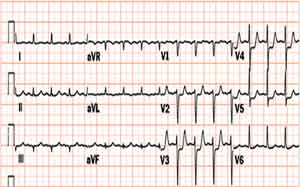Unstable angina non ST elevation myocardial infarction electrocardiogram
|
Unstable angina / NSTEMI Microchapters |
|
Differentiating Unstable Angina/Non-ST Elevation Myocardial Infarction from other Disorders |
|
Special Groups |
|
Diagnosis |
|
Laboratory Findings |
|
Treatment |
|
Antitplatelet Therapy |
|
Additional Management Considerations for Antiplatelet and Anticoagulant Therapy |
|
Risk Stratification Before Discharge for Patients With an Ischemia-Guided Strategy of NSTE-ACS |
|
Mechanical Reperfusion |
|
Discharge Care |
|
Case Studies |
|
Unstable angina non ST elevation myocardial infarction electrocardiogram On the Web |
|
FDA on Unstable angina non ST elevation myocardial infarction electrocardiogram |
|
CDC onUnstable angina non ST elevation myocardial infarction electrocardiogram |
|
Unstable angina non ST elevation myocardial infarction electrocardiogram in the news |
|
Blogs on Unstable angina non ST elevation myocardial infarction electrocardiogram |
|
to Hospitals Treating Unstable angina non ST elevation myocardial infarction electrocardiogram |
Editor-In-Chief: C. Michael Gibson, M.S., M.D. [1]; Associate Editors-In-Chief: Cafer Zorkun, M.D., Ph.D. [2]; Varun Kumar, M.B.B.S.; Lakshmi Gopalakrishnan, M.B.B.S.
Electrocardiogram in Unstable angina / NSTEMI
The resting electrocardiogram in the patient with unstable angina / non ST elevation MI may show any of the following:
- No changes
- Non specific ST / T wave changes
- Flipped or inverted T waves
- ST Depression as shown below. ST depression carries the poorest prognosis. Greater magnitudes of downsloping ST depression are associated with a poorer prognosis.
- Shown below is an EKG in case of unstable angina depicting ST depression.

- Shown below is an EKG in case of unstable angina depicting ST depression.

Shown below is one of the series of EKG of a patient who had a non-q myocardial infarction.

- Shown below is an example of EKG in case of non-Q MI with with deep T wave inversion in the anterior leads.

Sources
Copyleft images obtained courtesy of ECGpedia, http://en.ecgpedia.org/index.php?title=Special:NewFiles&offset=&limit=500